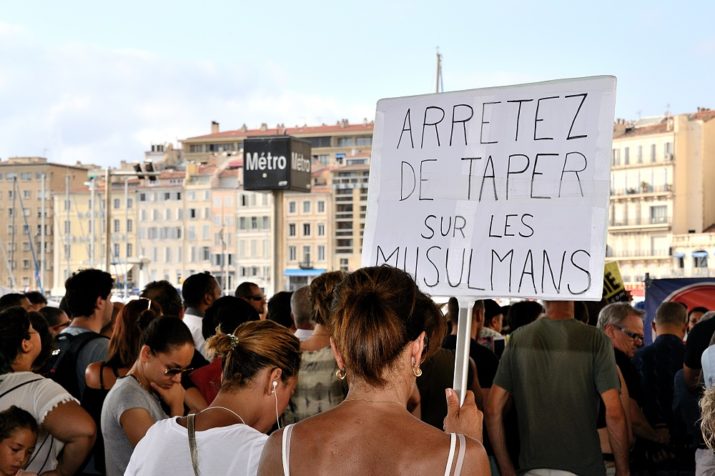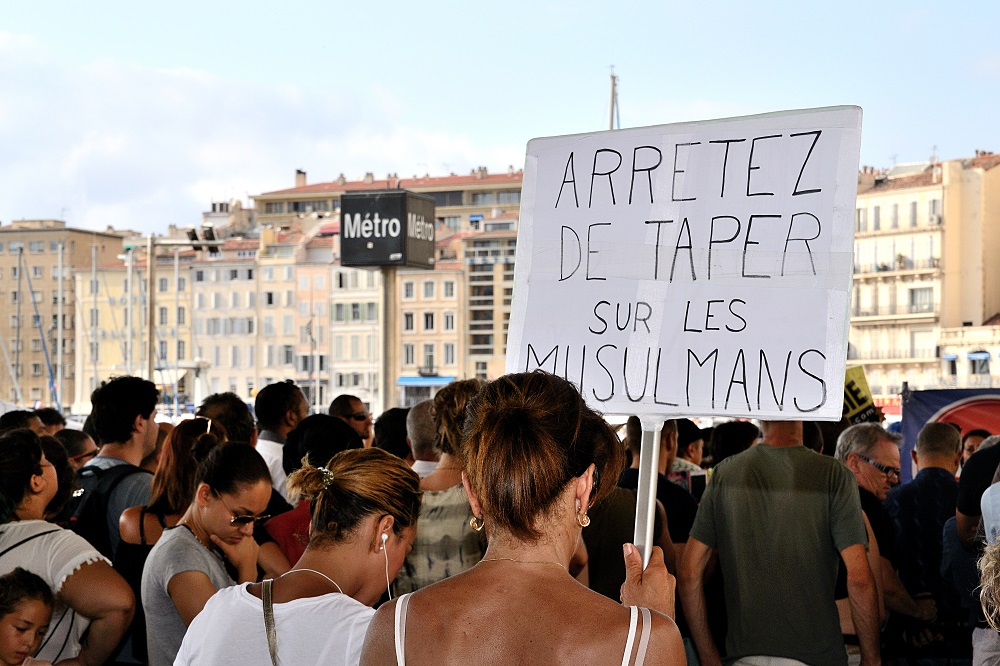

This is part of our special feature on Radicalism and Violence.
Since the end of the Cold War, the triangular relationship between the State, market, and civil society in Europe has been constantly reshaped, emphasizing culture’s ability to design social and economic structures and shape attitudes and worldviews. Most Muslims living in the European Union arrived during the 1960s, when the economy was booming. Europe’s need for cheap, unskilled, or semi-skilled labor force meant that migrants came typically from rural rather than urban areas. Former colonial ties played a significant role. In France, migration was largely from the former colonies and protectorates of the Maghreb, particularly Algeria, Morocco, and Tunisia. At first, mostly men came as migrant workers. Most of them settled in capital cities and large industrial areas. Thus, the dislocation they experienced was not only that of arriving in a different country, but also of migrating from rural villages to the industrial towns and cities. During the 1970s and the 1980s, they were joined by their families, and later by other groups—such as asylum seekers—in the 1990s.
In the 1980s, France, as many other Western European countries at that time, found itself confronted with “the settlement of immigrants,” as well as with ethnic and religious identity claims of groups within the immigrated population. It is at that time that multiculturalist policies began appearing across Europe in an effort to establish a possible solution, like in Canada. Each country started implementing its own version of multiculturalist policies, based on its national specifications. The policies carried out in the name of multiculturalism from the 1970s onward in the United Kingdom and Sweden—from the 1980s onward in Germany and the Netherlands; others, more recently— are each markedly different. They aim to define a conception of cultural, religious, and linguistic diversity, each more or less comprehensive, in accordance with principles of equality for every individual (equal representation, equal treatment and equal opportunity), and to maintain a cohesive national body. Such a conception is not easily constructed, and several nation and local beta programs had been introduced.
In this way, a policy of European multiculturalism was instituted in each country uniquely, incorporating an awareness of ethnic, religious, and/or socio- cultural vulnerable groups (i.e. women and homosexuals) by a variety of singular methods. Yet, in practice, Muslim communities have been clustered in group-assignment-zones with no future for their children. The second generation of immigrant Muslims tried both to establish a dialogue and to express themselves (i.e., the walking of “Beurs “in France in 1983). Governments have tried to sprinkle, appointing some of “the best minds” acting for the Muslim community to high offices of State. But they were used, brandished as alibis, with no leeway to implement effective change.
In the 2000s, social tensions that have become stronger—on regional, national, and international levels—further highlight the need of tolerance between and within societies, raising anew not only questions regarding the role of culture but also criteria inherent to these societies’ self-perception. The fear of judgment and discrimination, which in turn impacts job opportunities, has led to a general feeling of marginalization among the Muslim community in France, which is home to Europe’s largest Muslim population.[1] In 2004, the French government signed the law banning the wearing of any conspicuous religious symbols, including the headscarf. This decision by the French government encouraged other European countries to follow suit.
The years 2010 and 2011 marked one of the highest points of tension in identity politics apropos Islam—with further escalation in 2015 and 2016. The shock wave elicited by Angela Merkel’s statements on October 16, 2010, marked the end of state multiculturalism and disseminated across the whole of an unsuspecting EU. “This approach failed, failed utterly (…) The Multikulti is dead!” The rejection of multiculturalism started spreading like a trail of gunpowder, motivating other European leaders to imitate the German Chancellor. On February 5, 2011, the UK Prime Minister, David Cameron, declared: “Under the doctrine of state multiculturalism, we have encouraged different cultures to live separate lives, apart from each other and the mainstream.” According to Cameron, this has led to a “deficit in national identity” in Britain that drives young Muslims to embrace extremist ideologies.
In France, President Nicolas Sarkozy mirrored these sentiments a few days later, “Yes, it’s a failure. […] The truth is that within all of our democracies, we have been too concerned with the identities of those arriving and not enough with the identities of the receiving countries.” While France, UK, and Germany represent three completely different integrative models, it was certainly not a coincidence that their Heads of State had such a similar discourse. For several years now, Europeans have lived “in a mindset of civilizational defiance towards the Arab-Muslim world.” That official proclamation of “failure of multiculturalism” was indicative of Europe’s inability to situate Islam within its society, in an environment of mounting nationalism. In retrospect, it seems obvious that the very concept of multiculturalism has deviated from its initial sense to be replaced by a compromising and partial interpretation.
On top of this growing malaise all over Europe, the surge of Syrian refugees seeking for asylum into the EU has featured prominently in the anti-immigrant rhetoric of rightwing parties all over Europe, and in the heated debate over the UK’s decision to exit the EU. Since 2012, thousands of people have intended to seek asylum in Europe, risking their lives to embark on makeshift boats, most of which sank off the Cypriot and Greek coast. In 2015, migration and refugee movements in the Mediterranean countries gained unprecedented momentum. More than a million migrants and refugees crossed into Europe in 2015, sparking a crisis as countries struggled to cope with the influx, and creating division in the EU over how best to deal with resettling people. The so-called “refugee crisis” has become a central topic, which many actors linked to the issue of Muslims “invading” Europe
In the case of France, the terror attacks that occurred in Paris in 2015—most notably, the attacks on Charlie Hebdo and a kosher supermarket in January, and the Paris attacks in November—became a discursive event that caused an escalation of violence and Islamophobia on the national soil. Published in January 2016, the report of the French Delegation for the Fight Against Racism and Anti-Semitism (DILCRA) was alarming. While Islamophobic acts tripled in 2015, the recorded acts of racism increased by 22 percent compared to 2014, with 2,032 acts and verbal threats against 1,662 people a year before. (DILCRA, 2016).
Following the attacks, the “state of emergency” was instated in France and despite very mixed feeling among the public opinion, the French government extended it. Since then, the police have carried out abusive and discriminatory raids and house arrests against Muslims[2] under its sweeping new state of emergency law. The measures have created economic hardship, and stigmatized the French Muslim community even more.
During the summer of 2016, the barbaric murder of an 80-year old priest in his church in Normandy, followed by the Nice attacks where several hundred people were killed, crushed by a truck during the commemorations of Bastille Day on the evening of July 14, have further exasperated the feeling of rejection of the Muslim community and strengthened Islamophobia, especially in the South. It has reached a point where French Muslims—no matter their socioeconomic background(s)- are afraid to publicly declare that they do not eat pork, or that they may pray on a daily basis. They fear to be judged as “extremists,” and thus a threat to society.
Not only has Islamophobia drastically spread among the public opinion, but the French government also used it after the attacks as a tool against terrorism, in a very difficult context of public dissatisfaction, fear, economic recession, and national election coming[3].
The state of emergency and the continuation of extremist attacks in France dominated the 2017 French presidential election. Playing on fear and anxiety around the question of national security and identity, the campaign narrative has evolved into a “stake of civilization.” The focus has been on either immigration or mosques, while clearly assimilating Islam to terrorism. Marine Le Pen, leader of the far-right “Front National” Party, called repeatedly for dual-national terror suspects to have their French citizenship stripped from them.[4] In the final days of the campaign, she went even further by promising to immediately suspend all legal immigration in order to reassess what she called the “uncontrollable situation” of foreigners coming into France. She promised a ban on religious symbols, including the Muslim headscarf, from all public places, and announced the immediate expulsion of foreigners on the “Fiche-S” list of those linked to Islamism, as soon as she’d be elected.
These promises—in line with the traditional approach to counter-terrorism policies, rarely touching prevention—ignored the fact that the vast majority of the attacks carried out in France had been by French-born citizens, not immigrants, who in most cases had been radicalized in French prisons or in private schools (Khosrokhavar, 2015). Yet, her declarations had a strong impact at the end of the campaign, completing a split of the country in two camps.
The outburst of political and media mobilization to oppose the Far-Right-Wing and its political leader led to the election of Emmanuel Macron by a decisive margin, putting to bed at the same time most concerns about the rise of populism in the country. French citizens have been reassured: “France is not racist!” Yet, the number of violence due to Islamophobia and Antisemitism is alarming and keeps increasing. Social tensions further highlight the need for tolerance, not only between societies, but also within them, rising anew not only questions regarding the role of culture but also criteria inherent to these societies’ self-perception. Cultural differences, interfaith dialogue, and religious awareness are a reality that France and Europe can no longer ignore.
In his first major policy speech, President Macron declared that defeating terrorism would be his top priority, and soon announced the creation of a task force directly under his command. As early as November 2017, parliament passed a government proposal to make permanent some of the authorities granted under the state of emergency, including the ability to search, seize, and detain some terrorist suspects indefinitely. and without a judicial warrant. The law also authorizes continued military patrols in major cities, a significant investment in domestic intelligence collection, and the creation of a new anti-terrorism task force directly under Macron’s authority. The tone was set, the government would continue to implement counterterrorism policies focused on bolstering law enforcement and intelligence budgets and granting broad authority to detain and monitor suspects (Belkin, 2018). Yet, in February 2018, Prime Minister Philippe unveiled France’s new strategy to counter radicalization and fight terrorism, untitled “Prevent to Protect.” Involving specialists and ordinary people on both local and national levels, the sixty-measure-plan “aims to reorient the policy of prevention” around five goals: (1-) Protect against radicalization; (2-) Complete the detection / prevention mesh; (3-) Understand and anticipate the evolution of radicalization; (4-) Professionalize local actors and evaluate practices; (5-) Adapt the disengagement. (French Government – Matignon, 2018).
- The first axisinvolves the Education Ministry at a much higher level than in the previous plans. It is no longer only a matter of preventing conspiracies or promoting education about the media, the values of the Republic, or “laïcité” (French secularism). It is now about “fluidifying the detection” of radicalization by involving the heads of school and training the police and gendarmes involved in prevention missions in schools.
- The second axisincludes some of the toughest measures announced, and the most difficult to implement in France’s heavily regulated labor force, the removal of radicalized soldiers, police officers and civil servants from their duties, if necessary. Sports Federations are also mobilized in order to “detect and prevent” any risks of radicalization. Yet, as the government itself points out, certain activities at risk, such as bodybuilding or paintball, are not organized into federations.
- The third axis, devoted to knowledge of the phenomenon, provides some clear improvements compared to previous programs. The authorities seem finally interested in developing a French sector of expertise in radicalization.[5]
- As part of the professionalization of local actors, the evaluation of institutions involved in handling radicalized people by a committee of funders is to be noted as well as the inclusion of departmental councils, municipalities in an attempt to generalize radicalization prevention plans within the framework of city contracts. Because of the very individualized nature of “violent extremism”[6] individual actions and local initiatives are more likely to be effective. This new policy, thus, represents a major step.
- Finally, the fifth axis tackles the handling of radicalization. Targeting prisons, “disengagement” measures include doubling the number of prisoners evaluated for radicalization to 250 per year and increasing to 1,500 the number of cells devoted to radicalized inmates,[7] held in closed-off areas.[8] A recent wave of attacks against prison guards by radicalized inmates has weighed on the decisions and the doctrine strongly supports the concentration of radicalized prisoners. The plan also includes measures to “reintegrate” into French society minors returning from the battle zone amid the collapse of the Islamic State group in Iraq and Syria.[9] They will receive long-term care and psychological follow-ups.
Adopting such a comprehensive and multifaceted approach, involving twenty different ministries and State secretariats is a first, and represents a decisive step towards a continuous improvement of practices in France’s fight to counter violent extremism. As demonstrated by many scholars, it is crucial- to tackle the issue with a broader perspective, including prevention, to be able to confront the existential recognition promised by jihadists. “Any useful framework must be able to integrate mechanisms at micro (individual) and macro (societal/cultural) level.” (Velduis and Staun, 2009). Yet, if to that extent the plan seems quite promising, some loopholes are already obvious.
First and foremost, despite the promising name of the program “Prevent and Protect,” the primacy is clearly given to the detection and handling of radicalization. A few prevention actions have been announced among the first axis, such as media campaigns, and the launch of a new website stop-djihadisme.gouv.fr along with related accounts on Twitter and Facebook. These ideas are anything but new, as similar measures had been implemented by the previous government with no success. Therefore, it is deplorable that no detailed evaluation of previous actions had been done prior to elaborating a new strategy. Furthermore, as noted by Nicolas Hénin, “these accounts rarely engage directly with jihadist narratives, except during specific campaigns, such as #ToujoursLeChoix #AlwaysTheChoice” (Hénin, 2018). This is all the more disgraceful, as these efforts sometimes often have the opposite effect and provoke counter-campaigns. The priority, when it comes to targeting messages through the Internet, is to develop counter-messaging strategies and change the narrative. A recent study from the Carter Center, aiming to identify the flaws in violent Salafi groups’ narratives, specifically ISIS, has established that its “recruitment propaganda strategies center on the deployment of multiple narratives designed to heighten the socio-political grievances of its target audience.” Thus, in order to win the long-term fight against Islamic Jihadist movements, “we must confront their ideological foundations and provide the majority of Muslims with an alternative narrative that satisfies their social identity needs for a positive esteem” (Upal, 2015). However, it should be remembered that “messaging” is directly linked to real relationships, with family, mentors, and/or friends who influence the way you think. Therefore, CVE efforts and future strategies should explore this pathway of direct communication.
Measures involving the Higher Education institutions and instructors are, therefore, useful and moving in the right direction. Yet, many questions remain unanswered: First, many schools targeted by the plan are private schools run by Muslim organizations. Thus, as the prime Minister admitted himself, “the State cannot lead the fight without the Muslims of France, and it is crucial to acknowledge the fact that those efforts to prevent and counter violent extremism cannot succeed without the involvement of Muslim communities.
Second, in practice, what specific training shall instructors receive and how can we make sure it’s appropriate? Also, once students will be identified as “radicalized,” what should the procedure be? How do we “de-radicalize” them? Prime Minister Philippe stated that he rejects that term, because “no one knows how to deprogram an individual caught up in an evolving and little-understood phenomenon.” But, the plan did not come up with a working definition of radicalization either, when both should precisely be the government’s top-priorities, if it wants its new plan to succeed. There is, in fact, a plethora of definitions when it comes to “radicalization.” Ideology and action are sometimes connected, though not always, and “religious radicalization” is only one factor leading to terrorism (Borum, 2011). In order to define an effective strategy, it is important to identify what is really at stake and find a consensus. A working definition has been long-time needed, and would also help fighting stereotypes among the public opinion.
Violent extremism is a complex phenomenon, both to understand and to address. It is important to remember that there is no such thing as a “monolithic profile”[10] of a so-called European foreign terrorist fighter. Specific social and individual circumstances determine how people interpret and react to their environment: different pathways and mechanisms operate in different ways at different points in time, and in different contexts. Indeed, violent extremism is not a religious problem but a radical ideology manipulating religion—in this case, Islam—to indoctrinate recruits and make them serve its cause until death. France and Europe have to acknowledge the fact that they have been experiencing a generalized identity crisis, which is affecting not only large numbers of second and third-generation Muslims, but the youth population as a whole.
Dr. Aude Jehan-Robert received her PhD in political science from the Ecole des Hautes Etudes in Sciences Sociales in Paris. An accomplished expert on European foreign policy, transatlantic relations, counter violent extremism and international security, Dr. Jehan-Robert has held several positions in international organizations and in academia. She served as French Embassy Fellow at Johns Hopkins University Paul H. Nitze School of Advanced International Studies (SAIS), and as a visiting scholar at New York University and the University of California. She is a contributing editor at the journal EU-Topias, and a non-resident fellow at the Observatory for Security Studies at the University of Geneva in Switzerland.
Photo: Marseille, France – August 28, 2016 : Muslims gathered at the old port of Marseille for publicly express their anger at a political-media class that continues to fuel Islam phobia | Shutterstock
References:
Belkin, Paul, “France: Factors Shaping Foreign Policy, and Issues in U.S.-French Relations”, Report for the U.S. Research Congressional Congress, 2018.
Borum, Randy, “Radicalization into Violent Extremism I: A Review of Social Science Theories,” in Journal of Strategic Security, 4 (4): 7-36, 2011.
Chichizola, Jean, “Déradicalisation: les principales mesures du plan gouvernemental” [Deradicalization: The Principal Measures of the Governmental Plan], Le Figaro, February 23, 2018.
Comité interministériel de prévention de la délinquance et de la radicalisation (CIPDR), “Prévenir Pour Protéger : Plan national de prévention de la radicalisation” [Prevent to Protect: National Plan to Prevent Radicalization], Report of the French Government Media Services, February 23, 2018.
Délégation Interministérielle à la Lutte Contre le Racisme et l’Antisémitisme (DILCRA), Rapport –Bilan 2015, French Gouvernement, January 2016.
Jacquin, Jean-Baptiste, “Le gouvernement lance un plan tous azimuts de prévention de la radicalisation” [The Government Launches an Across-the-Board Plan to Prevent Radicalization], Le Monde, February 23, 2018.
Khosrokhavar, Farhad, “The Mill of Muslim Radicalism in France,” New York Times, January 25, 2015.
Patel, Faiza, Rethinking Radicalization, Brennan Center for Justice, New York University School of Law, 2011.
Hénin, Nicolas, “Prevent to Protect”: Analysis and Perspective on the French Program to Counter Terrorism and Radicalization, Report for European Eyes on Radicalization, 2018.
Neuman, Peter, Radicalization: Major Works Collection. London: Routledge, 2015.
Philippe, Edouard, Prime Minister of France, Official address before the Interministerial Committee for the Prevention of Delinquency and Radicalization (CIPDR): “Présentation du Plan national de prévention de la radicalisation” [“Presentation of the National Plan to Prevent Radicalization”], February 23, 2018.
Sayare, Scott, “Whatever Happened to France’s Famed ‘Liberté’?,” New York Times, March 30, 2017.
Upal, Afzal, “Confronting Islamic Jihadist Movements”, in Journal of Terrorism Research, May 2015.
Veldhuis, Tinka and Staun, Jørgen, Islamist Radicalisation: A Root Cause Model, Netherlands Institute of International Relations Clingendael, The Hague, 2009.
[1] With an estimated 5.7 million, or about 8.8% of the total population, as of 2017. Source: U.S. Congressional Research Service, 2018.
[2] Following unprecedented attacks in Paris and the Paris suburb of St. Denis on November 13, which killed 130 people and injured hundreds, French law enforcement officials have conducted more than 3,200 raids and placed between 350 and 400 people under house arrest. However, the counterterrorism unit of the Paris prosecutor’s office has opened only five terrorism-related investigations.
[3] The 2017 French presidential election was held on April 23 and May 7, 2017, with no less than eleven official candidates.[3] The independent centrist Emmanuel Macron had topped the first round of the French presidential election, and faced Marine Le Pen, in a standoff marked by anti-establishment anger that knocked France’s traditional political parties out of the race. It was the first time since 1958—when General Charles de Gaulle established The Fifth Republic—that the traditional left and right ruling parties were both ejected in the first round.
[4] Estimates indicate that up between 1,600 to 1,910 French nationals have traveled to fight in Syria and Iraq. As of November 2017, close to 700 French citizens reportedly remained in the region based on a study published by European Jihad Watch, November 2017.
[5] As a reminder, security studies are not a discipline of the French national curriculum and do not exist as such at present.
[6] In order to avoid any confusion, when referring to the process of indoctrination in extreme ideologies leading to terrorism, I use the term “violent extremism”.
[7] According to French official records, there are currently more than 500 inmates convicted of or awaiting trial for terrorism, and some 1,150 under watch for radicalization.
[8] As part of the plan, 450 “sealed” cells should be built by the end of 2018. Isolated from the rest of the prison system, they will be divided into different segments: Isolation Quarters (QI), Quarters for the Evaluation of Radicalization (QER), Radicalization Handling Quarters (QPR), and other specific quarters such as the Quarter for Violent Prisoners (QDV) in Lille-Annœullin. In the long term, the French Minister of Justice hopes to dispose of 1,500 dedicated and isolated cells.
[9] According to the Prime Minister 68 minors, mostly under 13, have returned so far.
[10] Term coined by Peter Neuman, 2015.
Published on October 2, 2018.




